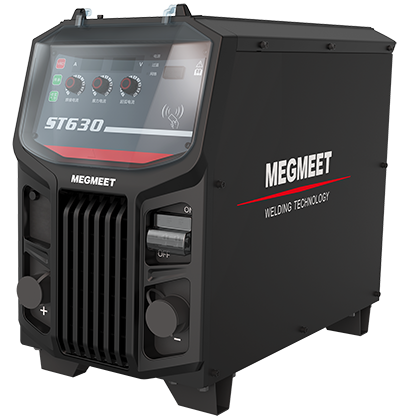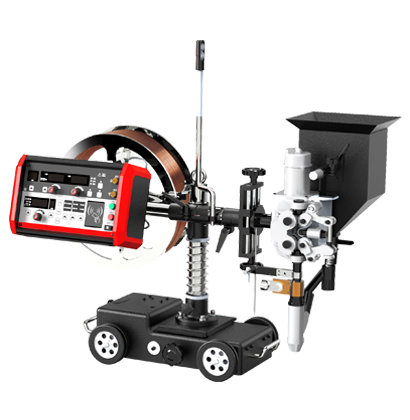In the intricate world of manufacturing, welders stand as indispensable tools, bridging metals and diverse materials together with precision. With an array of welding processes in demand, it's imperative to recognize that no single welding machine suits every requirement. Consequently, a diverse range of at least ten welder types has emerged to address the myriad of welding projects encountered in various industries.
Each type of machine for welding boasts its distinct attributes and capabilities, often varying in terms of price and characteristics. Below, we delve into both the widely recognized and lesser-known welding machine types, shedding light on their functions and applications:
1. MIG Welding Machine
MIG welding, or Metal Inert Gas welding, is renowned for its user-friendly nature. This method is particularly adept at handling large and thick materials. MIG welding machines employ a consumable wire as an electrode along with a filler material, leading to faster welding processes and reduced production costs.

Accompanied by an external gas tank containing shielding gas (typically Argon), MIG welders effectively work with an array of metals, including stainless steel, aluminum, magnesium, carbon steel, and copper. Industries spanning from automotive and construction to shipyards, robotics, farms, and home workshops find immense utility in these machines.
2. TIG Welding Machine
Tungsten Inert Gas (TIG) welding machines are favored for their precision and cleanliness, making them a prime choice for thin metals and intricate projects. While more demanding in terms of experience and multitasking, TIG welding involves the operator holding the welding torch with one hand and feeding the filler wire with the other. The process mandates a non-consumable tungsten electrode to produce the weld.

TIG machines require clean, rust-free surfaces for optimal weld quality. They find applications in welding steel, inox steel, Chromoly, aluminum, nickel alloys, magnesium, Titanium, copper, brass, and bronze. Notable uses range from repairing lawnmowers, bike frames, and door handles, to pipeline welding, aerospace, race car fabrication, artwork, and motorcycles.
3. Shielded Metal Arc Welding Machine (Stick)
Stick welding, scientifically known as Shielded Metal Arc Welding (SMAW), leverages an electric current between the base metal and the filler rod (or "stick") to generate welding heat. The filler rod is coated with a flux that inhibits oxidation and contamination by producing carbon dioxide gas during the welding process. SMAW welding machines are compatible with both AC and DC currents.

SMAW welders find their economic value in welding steel, inox steel, and cast iron. Their versatility makes them ideal for open spaces and outdoor applications such as pipeline welding, construction, farm equipment repairs, steel erection, and maintenance.
4. Flux-Cored Arc Welding Machine
Flux-Cored Arc Welding (FCAW) machines cater to thicker metals and out-of-position welding scenarios. FCAW welding machines exhibit remarkable adaptability, functioning effectively both indoors and outdoors. Employing a continuously-fed flux-filled electrode negates the need for external shielding gas or interrupting and restarting the welding process.
FCAW welders produce fewer electrode wastes and fumes compared to other methods while operating at remarkably high temperatures, approaching 1000 amps. Distinct from the MIG welding process, FCAW employs a different gas shield, contributing to its heightened power. This method is recommended for carbon steels, cast iron, nickel-based alloys, and some inox steel, with wide applications across the construction and fabrication sectors.
5. Plasma Arc Welding Machine
Plasma Transferred Stick Welding machines (PTAW) serve as industrial-sized counterparts to TIG welders, incorporating an anode that envelops the tungsten electrode. This configuration enhances precision, constraining the arc to a laser-like accuracy while safeguarding the electrode from filler material. These welders are primarily found in the aircraft manufacturing industry, characterized by their advanced features and relatively higher cost.
6. Submerged Arc Welding Machine
Submerged Arc Welding (SAW) machines operate by creating an electric arc between a continuously-fed electrode and the workpiece. In this technique, a reusable powder flux substitutes the gas shield, resulting in high-quality welds. Submerged arc welding's automatic or semi-automatic nature requires minimal operator experience, making it well-suited for steel, stainless steel, and steel and nickel alloys.

However, these machines are not portable due to their automated configuration. Plumbing, pipeline, and pressure vessel applications frequently benefit from this welding method.
7. Energy Beam Welding Machine
Energy Beam Welding (EBW) machines harness high-speed streams of tightly-focused electrons using magnetic fields, effectively joining thick metals with precision and minimizing heat distortion. This process finds application in power generation environments, as well as automotive, defense, medical, aerospace, and oil and gas industries.
However, due to the vacuum requirement to prevent electron beam absorption by air, EBW welding machines are unsuitable for home use. The technology is specialized, producing high-quality welds in demanding industrial contexts.
8. Atomic Hydrogen Welding Machine
Atomic Hydrogen Welding (AHW) machines utilize an arc generated between two tungsten electrodes and hydrogen shielding gas sourced from an external cylinder. The name "atomic hydrogen welding" refers to the arc's capacity to dissociate hydrogen into atomic form during the process.
While AHW welding machines offer rapid welding for thin and thick materials, they are gradually being replaced by more cost-effective MIG welding technology. These machines find compatibility with stainless steel, ferrous metals, non-ferrous metals, and select alloys.
9. Oxyacetylene Gas Welding Machine
Oxyacetylene welding, powered by a fuel gas (typically acetylene) and oxygen, serves as the heating medium for melting base metals and potential filler materials, creating welds. This method is particularly suitable for thinner materials, as operators can fine-tune temperature and weld bead characteristics through oxygen-to-fuel gas ratio adjustments.
While not as suited for thick materials, oxyacetylene welding remains popular due to its relatively low cost and portability. Applications span from fabrication projects and plumbing to automotive repair and fieldwork. Compatible metals include iron-based and ferrous materials.
10. Multipurpose Welding Machines
Multipurpose welders, often referred to as multi-process welders, offer the versatility of performing two or three types of welding on a single machine. For instance, 3-in-1 welders combine TIG, MIG, and stick welding functionalities into a single unit, eliminating the need for separate machines. While additional accessories might be required to switch between processes, the convenience and efficiency offered by multipurpose welders are notable. This streamlining of welding processes contributes to enhanced productivity and reduced equipment costs.

Megmeet, the best industrial welding machine manufacturer in China, has designed and manufactured a series of multifunctional welding machines such as MetaTIG AC/ACDC series, Ehave-2 CM Welder Series (CO₂/MAG/MIG/TIG/MMA/ Carbon Arc Gouging All-in-one Welding Machine), Ehave CM 350/400/500 Welder Series, Artsen II P(C)M Welder Series...... To know the details, you can contact us by clicking: https://www.megmeet-welding.com/en/contacts.
In conclusion, the world of welding machines is vast and diverse, offering a wide range of specialized tools to meet the needs of various industries and projects. From economical Stick welders, versatile MIG machines, and precise TIG welders to the powerful Flux-Cored Arc and the cutting-edge Energy Beam Welding, each type serves a unique purpose. As manufacturing continues to evolve, the availability of multipurpose welding machines adds to the efficiency and productivity of professionals. With these ten welding machine types, industries spanning construction, aerospace, pipelines, and more have the tools they need to create strong, reliable, and high-quality welds, making our modern world possible.
Related articles:
1. Top 10 Multiprocess Welders Recommended by Industry Experts
2. Top Inverter Welding Machine Brands in the World & How to Choose
3. Top 10 GMAW Welding Machine Brands in the World (in 2023)
4. Welding Machine Purchasing Guide & Top 5 Chinese Welder Brands
5. 2023 Top 5 Rated Laser Welders & Welding Machines for Sale








